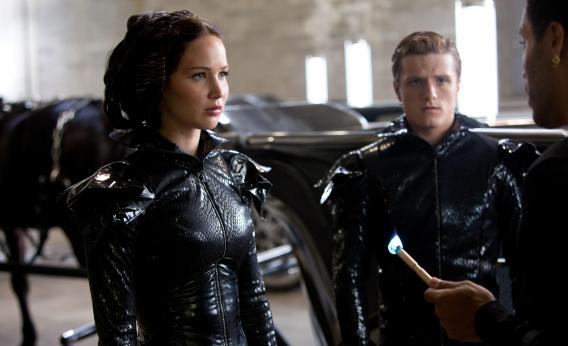The blockbuster new movie adaptation of the Hunger Games—the bestselling trilogy about teen contestants in a televised dystopian death match—gets many things right: Effie Trinket’s haughty accent. The Capitol’s gee-whiz gadgets. The race of diminutive combatant Rue. The determination and spirit of Katniss herself, played beautifully by Jennifer Lawrence.
But it gets one thing woefully wrong: Katniss’ “girl on fire” costumes. These outfits, readers of the books by Suzanne Collins will recall, play a critical role in the plot. Katniss turns up in the Capitol dirty, hairy, and scrawny (as you might expect of a scrappy hunter from a malnourished region). She is sent to a team of stylists who groom her for her first media appearances. Though she fears being painted, adorned, and dolled up in the exaggerated Capitol style, she finds an unexpected kinship with her stylist, Cinna, who understands her simple beauty. Playing off the coal mined in her district, he uses fire as his inspiration and dresses her in three show-stopping outfits based on flames. (In one, she gives “the illusion of wearing candlelight.”) His idea is to create something so unearthly and beautiful that Panem’s residents can’t forget Katniss—and can’t help but root for her.
These three outfits would present a challenge to any costume designer. Depicting the fantastical on celluloid can be tricky—as the Twilight effects gurus who botched vampire Edward’s sparkling skin know too well. (Along with the painters and directors who’ve tried to depict the unimaginable beauty of Helen of Troy over the years.)
But the outfits in the movie are duds. Consider the first one, described in the book as a “simple black unitard” paired with a “fluttering cape made of streams of orange, yellow and red” and “matching headpiece” that get lit on fire. This outfit becomes a shiny, oddly embossed, patent-leather breatplate, sans cape, that shoots bad-looking, computer-generated fireballs out behind our heroine. What should have been subtle, mesmerizing, swirling and alluring—a flickering cape of flame—looked like puffs of schlock-movie dragon breath, fake and faintly ridiculous.
And Katniss’ big interview dress is no better. Per the book, it’s “entirely covered in reflective precious gems, red and yellow and white with bits of blue that accent the tips of the flame design. The slightest movement gives the impression I am engulfed in tongues of fire.” The movie gives us this taffeta-looking monstrosity, a Jessica McClintock style that doesn’t look aflame at all—until Katniss spins around and the skirt is replaced with another bad, computer-generated fire effect (one not found in the original text).
What’s most disappointing about Katniss’ interview dress is how it shortchanges the costume designer’s art. Sure, we live in an era when you can pop computerized flames into any scene (and onto any outfit). But what a shame to rely on computer effects when there are so many luminous textiles and trims to play with: silks and sequins, chiffons and gemstones, beads and pleats and gathers. If the Hunger Games’ costume designers had used the magic of fashion to create Katniss’ supernaturally lovely look, the result would have been even more breathtaking—and made it that much more fun to root for her.
